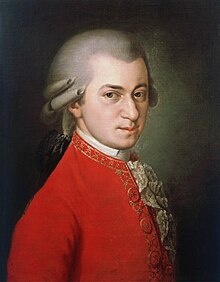Symphony No. 11 (Mozart)

Symphony No. 11 in D major, K. 84/73q, was at one time considered unquestionably to be the work of Wolfgang Amadeus Mozart. Its status has, however, been challenged, and remains uncertain. It is believed to date from 1770, and may have been written in Milan or Bologna, if it is a genuine Mozart work. An early manuscript from Vienna attributes the work to Wolfgang, but nineteenth-century copies of the score attribute it respectively to Leopold Mozart and to Carl Dittersdorf. Neal Zaslaw writes: "A comparison of the results of two stylistic analyses of the work's first movement with analyses of unquestionably genuine first movements of the period by the three composers suggests that Wolfgang is the most likely of the three to have been the composer of K73q".[1][2]
The symphony is in three movements, lacking a minuet and trio. Kenyon opines that there is "little special" about the work,[3] while Zaslaw finds a "Gluckish ambience", and some affinity with opera buffa in the repeated triplets found in the Finale.[1]
The first (Allegro) movement of this symphony is also employed as the first movement of the Musik zu einer Pantomime: Pantalon und Colombine (Music to a Pantomime) in D major, K. 446/416d (1783, incomplete) in the completion and orchestration by
Movements and instrumentation
The work is scored for 2 oboes, 2 horns in D, and strings.[1]
References
Sources
- Dearling, Robert: The Music of Wolfgang Amadeus Mozart: The Symphonies Associated University Presses Ltd, London 1982 ISBN 0-8386-2335-2
- ISBN 1-933648-23-6
- ISBN 0-19-816286-3
External links
- Sinfonie in D KV 84 (73q): Score and critical report (in German) in the Neue Mozart-Ausgabe
- Symphony No. 11: Scores at the International Music Score Library Project

